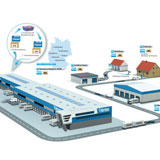"The art of driving is to be the fastest as slowly as possible”. These are the words of Formula 1 world champion Emerson Fittipaldi. The longer and more successful Hermes is in business, the more often this theory is confirmed. When the company first put its foot on the peddle in 1972, the roads were not as busy and speed was not the crucial factor. More important at first were the model and colour of its transporters. In the test phase before the company was founded, Hermes tried out VW transporters painted bright red, but then changed to blue Hanomag Henschel vehicles.
These gave a more elegant impression and showed off the logo better. The reason for the change was that this predecessor to the later commonplace Mercedes Benz 206 D (and all subsequent models right up to the modern-day “Sprinter”) was the best at meeting the high demands of daily delivery rounds. It was robust and spacious. The estate cars and vans could be quickly loaded and unloaded. It displayed outstanding driving qualities, both in town and on longer stretches. A high level of comfort and safety were guaranteed. And, moreover, the vehicle was cost-efficient in intensive use. The Ford Transit, which in some years made up 20% of the vehicle fleet, had similar qualities.
Alongside the issue of economy, environmental aspects played a major role. For this reason, Hermes always exchanges its leased models after only three years so as to use the latest emission classes. And as soon as the technical conditions seem right, it likes to experiment with alternative drive systems at an early stage. In 1993, Hermes acquired electric vehicles for the first time. In 1995, it tested natural-gas vehicles, and in 1997 hydrogen-powered vehicles. Shortly after the turn of the millennium, a delivery bike was even developed, but it took until 2011 before it was used in built-up areas, albeit with the addition of an electric engine. At present, a pilot project is underway involving twenty Vito E-CELL vehicles, whose quiet and clean technology does not produce any emissions at all.
Vehicle fleet As time goes by: the vehicle fleet
Headline






















